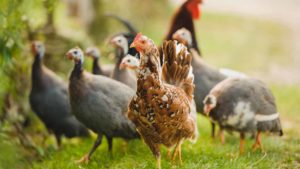Many first-time guinea-keepers find guinea fowl to be frustrating, confusing, even dumb. Often, their frustration is expressed in comparisons with chickens: My guineas won’t go in the coop at night, or when it rains (like my chickens do). They don’t use the nice nesting boxes like my chickens do – they lay their eggs out in the field where I can’t find them. They drag their babies all around, don’t pay attention to them, and the keets die; chickens make better mothers.
The fact is that guineas are not chickens. They may look similar, but they are very different, perhaps in more ways than they are similar. Guineas have different physiology, different flock social structure, different preferences for where to nest and where to roost, different ways of caring for their keets. And although a guinea fowl’s brain is approximately the same size as that of a chicken, it may be a more complex brain: Their flock structure and social relationships have been studied and have been found to be extremely complex.
The helmeted guinea fowl (which is the one species of guinea fowl that has been domesticated) evolved on the Savanna or grasslands, or semi-arid regions of Africa; chickens evolved in the jungle areas of Asia. This difference in environment often dictates the differences between the behavior of guineas and chickens.
Here are some of the ways that guineas are different from chickens.
In Africa, all prey animals are in herds or flocks. Guineas are hard-wired to be in large flocks (of their own kind; other poultry don’t count). When kept in small numbers, guineas are often fine until they reach adulthood, at which point they realize – Something is wrong! There aren’t enough of us to do all the jobs! Because they feel insecure and vulnerable, guineas in small numbers will often act out, developing behavior problems, including aggression toward other poultry, toward each other, or even toward people.
(Not all small flocks exhibit behavior problems, but nearly all reports of guineas acting aggressively come from people keeping small numbers of guineas.)
In small groups, guineas’ normal pecking-order behavior can become focused on just one bird, to the point where it becomes overwhelming and injurious.
The jungle fowl ancestors of chickens live in areas where there is thick cover and low perches (4-12m). Their territories are small, as close as 300’ apart, and the territories are defended by dominant males. There is a male dominance hierarchy; they live in flocks of a few males with several females; flock size is quite small, usually 4-8 total. The other males that are not in the hierarchy live alone or in small flocks of 2-4 roosters. Their diet consists of more plant material than insects and other small animals.
Chickens feel comfortable and secure in areas where there is dense vegetation. They enjoy hiding places.
In their native habitat, guinea fowl live in flocks of 25 or more, with approximately equal ratio of males to females. They can roam up to 6 miles a day. They are very efficient runners, and that is their primary instinct when threatened – to run rather than fly. An adult guinea’s heart is three times larger than that of a similar-sized chicken. Guineas are the marathoners of the poultry world. Keets, too, are more athletic compared with chicks. If you rear your keets in a brooder box, make sure that it’s quite large. Allow room for them to run and perch in order to properly develop their leg muscles. If you would be unable to move them out to the coop when they’re about four weeks old, have plans for a transitional environment for them, usually called a grow-out pen. At the very least, try to give them some outdoors time when the weather is good, in a sort of outdoor playpen. Being on grass and exposed to fresh air and sunshine will yield happier, healthier keets.
Up to 80% of a guinea’s diet is arthropods (insects) and small vertebrates and invertebrates.
Guinea fowl are known for their communal egg-laying, brooding, and rearing of their young. Both males and females will pitch in to help guide and protect the keets.
Two or three females will often share egg-sitting duty on the nest. Sometimes several will sit on the eggs full time; sometimes, one or two will just drop by every day to sit with the broody hen, keep her company, and gossip.
Unlike chickens, guineas usually do not use a nesting-box type of nest. Guineas have very specific ideas of what constitutes a good nesting site (and it’s never the same as your idea). Almost always, their nest will include a good line of sight and a good escape route to the side or the rear. If you are trying to encourage your guineas to nest in the coop, you’ll have better luck placing a few hay bales near the corners of the coop than with conventional nesting boxes.
Guineas often don’t do well using conventional poultry feeders. People often notice that there’s a lot of feed wasted. Most poultry feeders do not account for a guinea’s helmet or casque. It’s more difficult for a guinea to get at the feed in a feeder, so they prefer to scratch the feed out on the ground where they can more easily get to it. Save your money on poultry feeders, and scatter their feed out on the ground, in large plastic trays, or even in pieces of roof gutter.
Guineas evolved to roost in trees. Their feet are designed to allow the leg to fully relax only when the toes are curled. A shelf or a 2×4 on the broad side are not good roosts for guineas.
Guineas don’t instinctively go into a building to roost, as chickens do. However, guineas can easily be trained to go into the coop, to come to a call or a bell, and to be herded with herding-sticks. Guineas will also learn from chickens; they will learn to follow them into the coop, or to try new foods, or sometimes they’ll even be persuaded to use nesting boxes.
Guineas prefer high roosts. The cute little chicken coops sold at pet stores, with their small doors and cramped quarters, will not appeal to your guineas.
Guineas are physiologically drawn to light; having a light inside your coop will make it easier for you to train them to return to the coop for roosting, as it simulates the light up high in a tree as the sun is setting. When it’s dark, guineas are practically blind. They are virtually “sitting ducks” for predators if they’re not in a safe coop. It’s not a bad idea to leave a night light on in the coop (preferably a red light) to help prevent night-panic and night-fright injuries.
During bad weather, a chicken will instinctively seek shelter, but a guinea’s instinct is to hunker down and wait it out. Possibly because where they evolved, there wasn’t much in the way of shelter, it makes sense that they don’t look for shelter in a storm. Guineas can also become confused by snow. In their normal world, light equals “up” and dark equals “down.” Snow covering the ground causes great confusion, and guineas will usually fly up into trees or on rooftops and stay there, sometimes for days. Shoveling a big landing area or spreading hay or mulch will help convince them it’s safe to come down.
Guinea fowl lack the higher body fat and downy feathers that many other birds have. Therefore, they are more susceptible to cold weather, especially cold weather combined with wet or high-wind conditions. Both make it hard for guineas to retain body heat. Adding hay bales to your coop in very cold weather, or even a coop heater, will help your flock. A single weather event likely won’t take them down, but over time, exposure to cold, wet weather will take a toll.
Guinea fowl don’t really understand wire fences. It’s thought that this is because the visual portion of their brain is so large, and they can see through the fence or wire, they sort of don’t realize it’s there. They’re confused by this “invisible force shield.” This leads to behavior that we humans don’t understand: A guinea will fly over a fence, but then “forget” that he can fly back, and will run up and down the fence-line until you open a gate and walk him through. A guinea will peck at keets or youngsters that are being kept in a separate crate or section of the coop, and you might be tempted to think he’s exhibiting aggression. But he’s trying to communicate with the young birds, letting them know what the pecking order is or, in the case of very young keets, trying to get them to safety under her skirts. That “invisible force shield” is very frustrating to them.
As you might expect from birds that are very flock-oriented. Guineas are known for their communal egg-laying in a common nest, cooperative brooding with other hens, a male standing guard during the day, and communal rearing of their keets. A few days before hatching, members of the flock will gather around the nest. When the mother leaves the nest, the mother(s), the male, and other helpers from the flock will form a little group that helps the mom, guiding and protecting the keets. This is different from chickens, where only the hen who hatched the eggs will mother the chicks.
A guinea hen does not stay on the nest until every last egg hatches. She will leave the nest generally 24-48 hours after the first keet hatches. There are two reasons for this: The noise and movement of hatched and hatching keets will draw predators; late-hatching keets are generally weaker and less likely to survive, and will be unable to keep up with the flock. Keets are designed to range with the flock right from Day One, whereas chicks are content to spend a lot of their early days sitting close to or under their mothers.
Since guineas evolved in an arid climate, they are more susceptible to parasites associated with hot, humid conditions, such as coccidia. Keets are more susceptible to coccidiosis than chicks are, and even adult guineas can be affected if weather conditions are especially favorable to coccidia. Other than coccidiosis, guinea fowl are largely resistant to many of the poultry diseases that we worry about with chickens and turkeys.
With guinea fowl, it’s all about the flock. In fact, it’s difficult to re-home adult guineas – unless you’ve purchased the whole flock – because adult guineas to leave their new home, looking for their flock. No matter how long you keep them penned, hoping they’ll be imprinted to the new location, they still want their flock. Separation from the flock causes stress for guineas. Sick or injured chicken might be best served if kept separated from the flock, but for guineas, the stress of being isolated may well do more harm than good. If separating is necessary, it’s best to keep the bird in a place where he can see and interact with the flock.
As a flock, guineas will be watchful for predators and alarm earlier – especially to aerial predators – than many other species. Guineas have been seen to take on and drive away bobcats, foxes, coyotes, hawks, and even large snakes. Keep in mind, though, that they need to be in a good-sized flock. In small numbers, they will run or take cover rather than face down a predator.
In short, guineas have their own special ways of going about things. They have their own physical requirements, their own social structure, and their own quirks. Above all, remember that guineas are not chickens!








